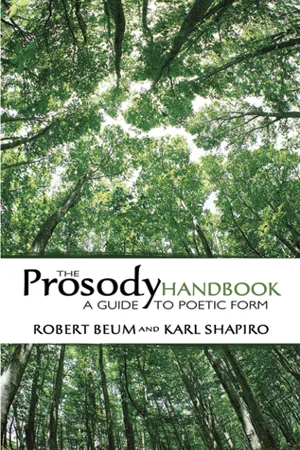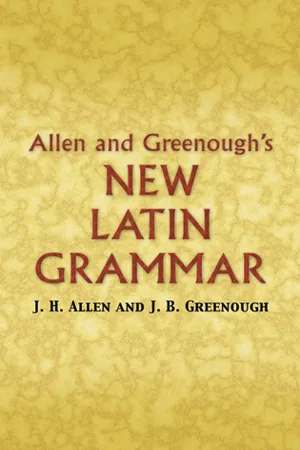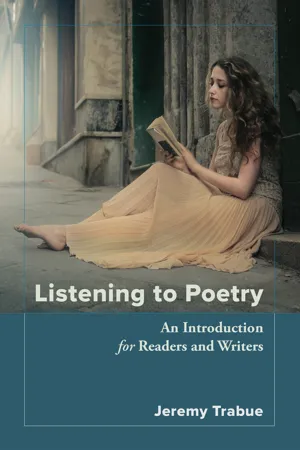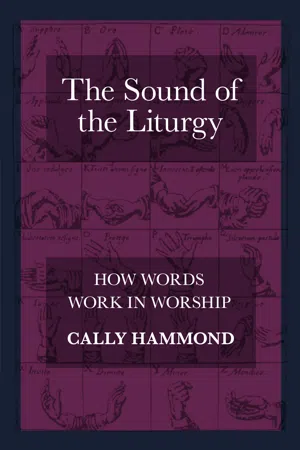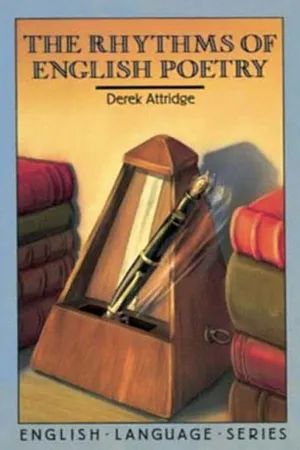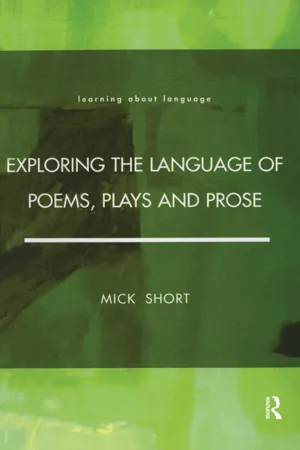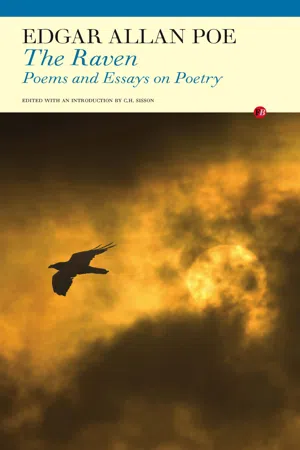Literature
Trochaic
Trochaic is a metrical foot in poetry consisting of a stressed syllable followed by an unstressed syllable. It is the opposite of iambic meter, which has an unstressed syllable followed by a stressed syllable. Trochaic meter is commonly used in poetry and is known for its strong, rhythmic quality.
Written by Perlego with AI-assistance
8 Key excerpts on "Trochaic"
- eBook - ePub
The Prosody Handbook
A Guide to Poetic Form
- Robert Beum, Karl Shapiro(Authors)
- 2012(Publication Date)
- Dover Publications(Publisher)
abundance of stresses . Now, in English prose the ratio of nonstresses to stresses ranges from about 2 : 1 to 3 : 1. This means that in the more intense language of poetry, one should expect the ratio to be closer to 1 : 1, and we find that in fact 9 : 7 is a common figure. Clearly, then, a balance or near balance between troughs and crests is called for.But of course a trochee gives us this balance as well as an iamb. It may be that the vocabulary and syntax of modern English run counter to Trochaic meter. It is certainly true that our most ubiquitous nouns are words of one or two syllables (in the latter the stress usually falls on the first syllable), and that these are ordinarily preceded by unstressed articles, prepositions, or conjunctions :There is another possible strike against the trochee. Eager as we are in reading a line of verse to get to a stress, we may not be so eager as to delight very often in starting the line with a stress. To begin lines with stresses is perhaps too emphatic for ordinary purposes; the physical effort required to raise pitch and force possibly ignores a desire to anticipate the vocal intensity—to be led up to it by first entering upon a lower level. In a long poem, Trochaic verse tends to make the first word of the line overly emphatic.Another point is that much poetry, lyric as well as dramatic, is intended to suggest the relatively relaxed and artless qualities of ordinary speech, whether dialogue, as in the verse play and the dramatic poem, or the poet’s own voice. If it does strive for linguistic and physiological naturalness, then iambic is ordinarily the meter best suited to its purpose: it best suggests the structures of informal speech. Greek and Roman poets explicitly recognized this suitability, and used quantitative iambic meter extensively for subjects of less than exalted character: for homely verse, for the lampoon, and for more intellectual satire. The Latin iambus - eBook - ePub
- James B Greenough, J. H. Allen, G. L. Kittredge, A. A. Howard, Benj. L. D'Ooge, G. L. Kittredge(Authors)
- 2013(Publication Date)
- Dover Publications(Publisher)
2. The Iambic Dimeter Catalectic consists of three and a half iambic feet. It is used only in choruses: —NOTE . — Owing to the fact that in modern music each measure begins with a downward beat, some scholars regard all these forms of Iambic verse as Trochaic verse with anacrusis (§ 618 , c . N .).TROCHAIC VERSE620. The most common form of Trochaic verse is the Tetrameter Catalectic (Septēnārius ), consisting of four dipodies, the last of which lacks a syllable. There is regularly diaeresis after the fourth foot: —In musical notation : – In English verse: — Téll me nót in moúrnful numbers || life is bút an émpty dreám.— Longfellow ,The metrical scheme of these four verses is as follows: —a.In the stricter form of the Septenarius substitutions are allowed only in the even feet, but in comedy the tribrach , or an irrational spondee , cyclic dactyl , or apparent anapaest , may be substituted for any of the first six feet; a tribrach for the seventh: —Substitutions as in the Septenarius are allowed except in the last foot.b.The Trochaic Tetrameter Acatalectic (Octōnārius ), consisting of four complete dipodies, occurs in the lyrical parts of comedy.c.Some other forms of Trochaic verse are found in the lyric poets, in combination with other feet, either as whole lines or parts of lines: —MIXED MEASURES621. Different measures may be combined in the same verse in two different ways. Either (1) a series of one kind is simply joined to a series of another kind (compare the changes of rhythm not uncommon in modern music); or (2) single feet of other measures are combined with the prevailing measures, in which case these odd feet are adapted by changing their quantity so that they become irrational (see § 609 . e ).When enough measures of one kind occur to form a series, we may suppose a change of rhythm; when they are isolated, we must suppose adaptation. Of the indefinite number of possible combinations but few are found in Latin poetry. - eBook - ePub
- Gilbert Norwood(Author)
- 2022(Publication Date)
- Routledge(Publisher)
only as used in the non-lyrical passages of comedy. Originally all dialogue was written in this metre ; but in extant comedy it is mostly confined to recitative by the chorus. The metre is always the Trochaic tetrameter catalectic (sometimes called the Trochaic octonarius), that is, a line consisting of eight feet, mostly trochees, with catalexis.Pure Trochaic verses are occasionally to be found :The mark Λ means that there is a pause equivalent in length to a short syllable. (It is often found in the scansion of lyrics, and there one also at times uses which mean pauses equivalent to two, three, and four short syllables respectively.) As in iambics, the last syllable may be short by nature :Such purely Trochaic lines are rare. Spondees are used freely in the second, fourth, and sixth feet:Tribrachs, too, are very common :This foot may occur in any of the seven places, but is extremely rare in the fourth and seventh :Dactyls and anapaests are very rare. There is no rule as to caesura, but, as in the iambic tetrameter, diaeresis normally occurs at the end of the fourth foot.It will be seen that the Trochaic tetrameter catalectic is almost as regular in comedy as in tragedy. This magnificent metre is in fact one of the finest and best loved elements in all poetry. Aristotle 1 indeed imputes to it lack of dignity, if not of decency : we should rather call it popular. Throughout the history of western civilization its splendid leaping vigour has been employed wherever simple strong emotion was to be expressed. Archilochus, the earliest of personal poets, employs it in his virile songs of love and revelry :Epicharmus throws into this same form his vigorous popular philosophy:1 Poet, IV, 14 : In Rhet, III, i, 9, he calls it κορδκι-Attic drama is full of it. Æschylus has set some of his most magnificent poetry in this measure : - eBook - ePub
Listening to Poetry
An Introduction for Readers and Writers
- Jeremy Trabue(Author)
- 2019(Publication Date)
- Chemeketa Press(Publisher)
You’ve also observed that every line starts with a stressed syllable. Nine out of twelve end with an unstressed syllable. Every line has an even number of syllables, either eight or four, which is not divisible by three. That suggests you are looking at lines of two-syllable feet rather than three-syllable feet. What is the two-syllable foot moving from stressed to unstressed? The trochee. If you try to divide this into trochees, how does it go? Remember, start at the back and work forward, at least at first. A single vertical line separates each foot:Sil• ver |bark• of |beech, • and |sall• owBark• of |yell• ow |birch• and |yell• owTwig• of |will• ow.Stripe• of |green• in |moose• wood |ma• ple,Col• our |seen• in |leaf• of |ap• ple,Bark• of |pop• ple.Wood• of |pop• ple |pale• as |moon•beam,Wood• of |oak• for |yoke• and |barn- •beam,Wood• of |horn•beam.Sil• ver |bark• of |beech, • and |holl• owStem• of |el• der, |tall• and |yell• owTwig• of |will• ow.Perfect! The lines divide consistently into trochees. The only exceptions are in lines 7–9, where the final foot of each line is a spondee. Even with this variation, the majority of feet in each line and in the poem overall are trochees. You can tentatively identify the dominant foot as the trochee.How long are the lines? Count the feet. Most are four feet, and some are two. Because the majority are four feet long, the meter should be called Trochaic tetrameter—“Trochaic” because the dominant foot is the trochee and “tetrameter” because the most common line length is four feet.A full description of the meter of the poem would require a little more information, though. It would go something like this: “This poem is mostly in perfectly regular Trochaic tetrameter, though every tercet ends with a dimeter line and every line in the third tercet ends with a spondee.”This poem has a very regular and straightforward meter, so it’s a good starting point for you. A lot of the fun to be had and insight to be gained, however, comes from scanning poems that use more complex patterns to create more varied, interesting, and sophisticated rhythms. - eBook - ePub
The Sound of the Liturgy
How Words Work In Worship
- Cally Hammond(Author)
- 2015(Publication Date)
- SPCK Publishing(Publisher)
42¯ long, heavy, accented, strong or stressed syllable ˘ short, light, unaccented, weak or unstressed syllable Iambic (˘ ¯) unstressed→ stressed→Trochaic43(¯ ˘) stressed→ unstressedAnapaest44(˘ ˘ ˘ ¯) unstressed→ unstressed→ unstressed→ stressedDactylic45(¯ ˘ ˘) stressed → unstressed→ unstressedSpondaic46(¯ ¯) stressed→ stressedTribrach47(˘ ˘ ˘) unstressed→ unstressed→ unstressed‘Iambic’ and ‘Trochaic’ at least are familiar terms in the study of English poetry:48 these and other metrical terms originating in ancient Greek literary criticism can also be applied to the cadences (sentence- or clause-endings) of prose texts as well as poetry. This terminology is not exactly satisfactory, not least because it was devised to suit two alien ancient languages with sounds and speech patterns very different from ‘modern’ (i.e. sixteenth-century and later) English. A wide-ranging argument like the present one is not the place to enter into the more arcane technicalities of this topic; it is enough here to employ this scheme as an adequate shorthand for identifying patterns. What matters here is not the precise nature of the patterns observable, but the identification of such patterns in written liturgical English texts.Thomas Cranmer (1489–1556) was writing at the time when English artistic, literary, liturgical, rhetorical, written prose was being born. He himself was one of its founders. It ought to be possible to learn, from his successes (and failures) in composing liturgical English, how to compose better liturgical texts today. That will necessitate close attention to the consonance of such liturgical texts with the natural cadences of English speech. Critical terms such as ‘vivid’, ‘solemn’ and ‘poetic’ are impossible abstracts to pin down.49 Sound and rhythm, on the other hand, are not. So with the help of the immense depth of expertise of Classical rhetorical theory (lightly drawn on) it is possible to understand them better. Hence the quotation from Cicero about how people hear. This body of expertise can help to explain not just whether , but also how - eBook - ePub
- Derek Attridge(Author)
- 2014(Publication Date)
- Routledge(Publisher)
ternary metres. The following are examples of the four types of metre in differing line-lengths:In order to relate these simple schemes to the much more varied lines which poets actually write, the classical approach has recourse to the notion of substitution, according to which the feet of the basic metre can be replaced by other feet. Thus a trochee can be substituted for an iamb, and vice versa; and a spondee or a pyrrhic for either. The following lines will serve as an illustration, the lower set of symbols indicating the basic metre, and the upper set the actual stresses and nonstresses of a possible reading:In the basic metre, three lines of iambic tetrameter are followed by an iambic trimeter. However, each of the three tetrameters has one pyrrhic substitution; the third line begins with a Trochaic substitution (often called an inversion, and in this position an initial inversion); and the final line begins with a spondaic substitution. It is also possible to replace a duple foot by a triple foot; this is known as trisyllabic substitution, and its most common form involves the doubling of the unstressed syllable to replace an iamb by an anapaest, or a trochee by a dactyl. Thus in the following example the iambic tetrameters are varied by means of an occasional anapaestic substitution (I show only the substituted feet on the upper level):Triple metres are dealt with on the same principle, though less elegantly, since the many possible substitute feet demand further raids on the stock of Greek prosodic terminology.Another classical term inherited by English prosody with a changed signification is caesura. In the analysis of English verse it is used to refer to a pause within the line created by the syntax; thus one can say that in (5 ) the first and the fourth lines have a prominent caesura, the former after the third and the latter after the second syllable. The term does not refer to anything in the structure of most English verse, however, and there is no reason to prefer it to ‘pause’ or ‘syntactic break’ in describing a line. Two other terms, of more value in metrical discussion, can be introduced here: a line which ends with a syntactic break is end-stopped, and one which does not is run-on (or enjambed). All the lines in (5 ) are end-stopped; the first line of (6 ) is run-on. It is also worth mentioning a metrical phenomenon which the classical approach does not easily accommodate: lines of iambic verse may have an extra unstressed syllable, or occasionally two, after the final stress; these are, respectively, feminine and triple endings (as opposed to the masculine - eBook - ePub
- Mick Short(Author)
- 2018(Publication Date)
- Routledge(Publisher)
But because the line lengths are now very irregular we do not feel that the rhythmic properties of each line are parallel to one another. It is this extra regularity which makes metre what it is. Metred poems, then, are poems where the line lengths and rhythmical patterns within the lines are close enough for us to feel a basic pattern of equivalence from line to line. This is why explaining how the different poetic metres work is an important aspect of explaining rhythm in poetry. 5.4 Different kinds of metre Metre in English verse is a level of organisation which is based upon a two—term contrast between positions in a line which should contain strong and weak syllables. Let us use the traditional terms ictus (/) and remiss (X) to refer to these strong and weak positions respectively. If we restrict ourselves for the moment to a situation where these two positions are only allowed to contain one syllable each, we can see that there are two possible patterns of weak and strong events, X /('di dum') and / X ('dum di'). These two elementary patterns are essential to an understanding of English metrics. The first pattern, X / ('di dum') is traditionally called the iamb and the / X ('dum di') pattern is called the trochee. The basic metrical unit of one strong plus one weak (ictus plus remiss) position is traditionally referred to as the metrical foot. Thus we can find iambic feet, Trochaic feet, and also other combinations when the basic unit is expanded to include more than two syllables in the remiss of the foot (the metrical foot must have one and only one ictus syllable, but can normally have from zero to three remiss syllables). Below I list, with illustrative examples, the major foot structures that can be found with any regularity. Some are much more common than others, the iambic foot being by far the most widespread in English verse - eBook - ePub
The Raven
Poems and Essays on Poetry
- Edgar Allan Poe, C.H. Sisson, C.H. Sisson(Authors)
- 2012(Publication Date)
- Fyfield Books(Publisher)
trochee.We come now to the final division (me) of Mr Cranch’s line. It is clear that this foot, short as it appears, is fully equal in time to each of the preceding. It is in fact the cæsura – the foot which, in the beginning of this paper, I called the most important in all verse. Its chief office is that of pause or termination; and here – at the end of a line – its use is easy, because there is no danger of misapprehending its value. We pause on it, by a seeming necessity , just so long as it has taken us to pronounce the preceding feet, whether iambuses, trochees, dactyls, or anapæsts. It is thus a variable foot, and, with some care, may be well introduced into the body of a line, as in a little poem of great beauty by Mrs Welby:I have | a lit | tle step | | of on| ly three | years old. |Here we dwell on the cæsura, son, just as long as it requires us to pronounce either of the preceding or succeeding iambuses. Its value, therefore, in this line, is that of three short syllables. In the following dactylic line its value is that of four short syllables.Pale as a | lily was | Emily |I have accented the cæsura with a by way of expressing this variability of value.I observed, just now, that there could be no such foot as one of two short syllables. What we start from in the very beginning of all idea on the topic of verse, is quantity, length. Thus when we enunciate an independent syllable it is long, as a matter of course. If we enunciate two, dwelling on both equally, we express equality in the enumeration, or length, and have a right to call them two long syllables. If we dwell on one more than the other, we have also a right to call one short, because it is short in relation to the other. But if we dwell on both equally and with a tripping voice, saying to ourselves here are two short syllables, the query might well be asked of us – ‘in relation to what are they short?’ Shortness is but the negation of length. To say, then, that two syllables, placed independently of any other syllable, are short, is merely to say that they have no positive length, or enunciation – in other words that they are no syllables – that they do not exist at all. And if, persisting, we add anything about their equality, where, x being equal to x, nothing is shown to be equal to zero. In a word, we can form no conception of a pyrrhic as of an independent
Index pages curate the most relevant extracts from our library of academic textbooks. They’ve been created using an in-house natural language model (NLM), each adding context and meaning to key research topics.
Explore more topic indexes
Explore more topic indexes
1 of 6
Explore more topic indexes
1 of 4
